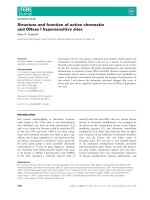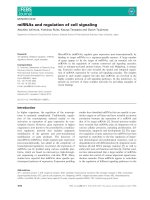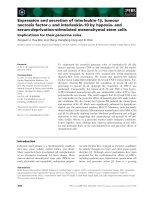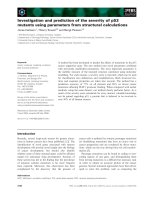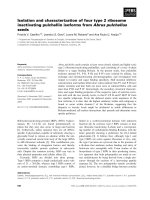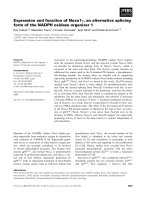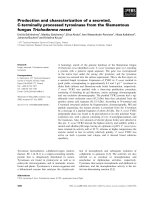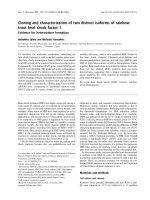Báo cáo khoa học: "Structure and development of vegetative buds, from the lower crown of Picea abies" pptx
Bạn đang xem bản rút gọn của tài liệu. Xem và tải ngay bản đầy đủ của tài liệu tại đây (3.96 MB, 15 trang )
Original
article
Structure
and
development
of
vegetative
buds,
from
the
lower
crown
of
Picea
abies
A
Hejnowicz,
E
Obarska
Department
of
Genetics,
Institute
of
Dendrology,
Polish
Academy
of
Sciences,
62-035
Kórnik,
Poland
(Received
20
December
1993;
accepted
8
March
1995)
Summary —
Seasonal
changes
in
the
development
of
Norway
spruce
(Picea
abies
(L)
Karst)
vege-
tative
buds
in
the
lower
crown
position
of
4
18-year-old
free
standing
grafts
in
the
climatic
conditions
of
Poland
are
described.
Bud
awakening
varies with
the
season
while
the
end
of
shoot
elongation,
after
about
6
weeks,
seems
to
be
weather
independent.
Mitotic
activity
of
the
embryonic
shoot
starts
about
1
month
before
bud-burst.
The
new
winter
bud
develops
in
2
periods
of
bud
scale
primordia
initiation
(autumn
and
spring)
and
1
period
of
needle
primordia
initiation
(during
summer).
The
curves
of
apical
dome
size
(width
and
height)
have
2
peaks:
the
1 st
one,
in
late
April
just
before
the
1 st
spring
bud
scale
primordium
emerges,
and
the
2nd
one,
during
the
time
of
rapid
needle
initiation
(mid-August).
There
is
seasonal
variation
in
starch
accumulation.
Starch
is
absent
in
the
dormant
bud.
In
the
developing
bud,
starch
is
associated
with
areas
of
high
morphogenic
activity.
Picea
abies
/
spruce
/
vegetative
bud
/
anatomy
/
development
Résumé —
Structure
et
développement
des
bourgeons
végétatifs
de
la
partie
basse
de
la
cou-
ronne
de
Picea
abies.
L’étude
porte
sur
les
changements
au
cours
du
temps,
et
dans
les
conditions
climatiques
de
la
Pologne,
observés
dans
le
développement
de
bourgeons
végétatifs
situés
dans
la
par-
tie
basse
de
la
couronne
d’épicéas
communs
(Picea
abies
(L)
Karst).
Elle
concerne
4
arbres
greffés,
âgés
de
18
ans,
et
poussant
hors
concurrence.
La
reprise
de
croissance
des
bourgeons
varie
selon
les
conditions
saisonnières
propres
à
chaque
année,
alors
que
la
fin
d’élongation
des
pousses,
environ
6
sem
après
le
débourrement,
semble
indépendante
du
climat.
L’activité
mitotique
de
la jeune
pousse
située
dans
le
bourgeon
commence
environ
un
mois
avant
le
débourrement.
Le
nouveau
bourgeon
hiver-
nal
se
développe
en
2
temps
pour
ce
qui
est
de
l’initiation
des
primordia
d’écailles
de
ce
bourgeon
(à
l’automne
et
au
printemps),
et
en
un
seul
temps
pour
l’initiation
des
primordia
d’aiguilles
(durant
l’été).
Les
courbes
de
croissance
en
diamètre
et
en
hauteur
du
dome
apical
présentent
2
pics :
le
premier
fin
avril,
juste
avant
que
n’émergent
les
primordia
des
premières
écailles
de
printemps,
le
second
durant
la
période
de
rapide
initiation
des
primordia
d’aiguilles
(mi-août).
On
observe
une
variation
saison-
nière
dans
l’accumulation
de
l’amidon.
Il
est
absent
dans
les
bourgeons
dormants
alors
que,
dans
les
bourgeons
en
développement,
il
est
associé
aux
zones
présentant
une
forte
activité
morphogénétique.
Picea
abies
/ épicéa / bourgeon
végétatif / anatomie / développement
INTRODUCTION
Development
of
vegetative
buds
from
the
lower
crown
in
Picea
abies
was
studied.
There
are
several
reports
on
this
topic
con-
cerning
Picea
species
other
than
Picea
abies
(eg,
Owens
et
al,
1977;
Pillai
and
Chacko,
1978;
Tompsett,
1978;
Harrison
and
Owens,
1983;
Skupchenko,
1984).
Our
6
years
of
study
on
bud
development
in
Nor-
way
spruce
concerned:
i)
seasonal
development
of
the
vegetative
bud
(manifestation
of
bud
awakening,
mor-
phogenic
and
mitotic
activity
of
the
apical
meristem);
ii)
seasonal
changes
in
apical
meristem
dimensions;
iii)
dates
of
onset
and
termination
of
shoot
elongation;
iv)
seasonal
changes
of
starch
accumula-
tion
in
the
embryonic
shoot;
and
v)
changes
in
the
metabolism
of
tannin
vac-
uoles.
MATERIALS
AND
METHODS
In
1986,
4
free-standing
18-year-old
grafts
of
1
clone
in
a
clonal
archive
at
Zwierzyniec
near
Kórnik
(longitude
17°04’,
latitude
52°15’,
altitude
70
m)
were
selected
for
morphological
and
anatomical
studies.
The
selected
clone
K-15-33
originates
from
Stronie
Slaskie.
Chosen
grafts
were
approximately
of
the
same
height
(7-8
m)
and
vigor.
Studies
were
carried
out
on
shoots
from
the
lower
crown
zone
(excluding
3
or
4
lowest
living
branch
whorls).
This
zone
was
selected
for
exper-
imental
studies
on
male
buds
initiation.
The
time
table
(month.day)
for
collecting
and
fixing
of
specimens
for
histological
studies
was
as
follows:
years:
1986 -
04.25, 05.08,
05.27,
06.27, 07.23,
08.11, 09.09,
10.20,
12.03
1987 -
01.26, 02.25, 03.26, 04.15,
and
from
04.27
to
12.28
weekly
1992 -
from
03.05
to
11.10
weekly.
Also
information
was
used
from
another
study
on
the
same
clone
and
on
ramets
of
the
same
age.
Material
was
collected:
1988 -
from
01.06
to
05.16
weekly,
and
07.11,
08.23
1989 -
01.27,
05.02,
05.03,
05.11,
05.12,
06.20,
07.25, 09.19
1990 - 03.23,
10.10.
Buds
with
or
without
scales
(depending
on
the
stage
of
bud
development)
were
fixed
in
Craf
solu-
tion
(in
proportion:
0.8
g
chromic
acid,
3
ml
glacial
acetic
acid
and
20
ml 40%
formaldehyde).
Spec-
imens
were
dehydrated
in
ethyl
alcohol
and
through
benzene
embedded
in
paraffin.
Trans-
verse
and
longitudinal
sections
9
μm
thick
were
stained
with
Ehrlich
hematoxylin
by
the
progressive
method
(modified
Gerlach,
1969).
For cytochem-
ical
analysis,
specimens
were
treated
with
Schif-
f’s
reagent
for
Feulgen
(counterstained
with
Fast
green)
or
PAS
(periodic
acid
Schiff)
reaction
(mod-
ified
Berlyn
and
Miksche,
1976).
Details
of
these
methods
were
described
in
Hejnowicz
(1982).
Dimensions
of
the
apices
were
established
on
longitudinal
median
sections
using
the
ocular
micrometer.
Mitotic
indices
on
permanent
speci-
mens
were
calculated
on
series
of
transverse
sections
after
the
Feulgen
reaction.
Occasionally
during
the
warm
winter
of
1990,
mitotic
activity
of
embryonic
shoot
was
checked
on
squash
specimens
with
the
aceto-carmin
method
(Gerlach,
1969).
In
1988, 1990,
1991
and
1992,
the
dates
of
starting
and
termination
of
shoot
growth,
as
well
as
the
rate
of
shoot
elongation,
were
established
on
branches
from
the
same
part
of
the
crown
of
2
trees.
Terminal
and
distal
lateral
buds/shoots
were
measured
weekly
from
early
spring
to
mid-June.
RESULTS
Structure
and
development
of
the
winter
buds
The
winter
resting
bud
of
Norway
spruce,
encased
in
bud
scales,
possesses
an
embryonic
shoot
bearing
all
of
the
next
year’s
needle
primordia,
which
delimit
stem
units
(=
internode
+
node;
Doak,
1935),
but
not
the
lateral
bud
primordia.
The
dormant
embryonic
shoot
averages
2
mm
in
length
and
is
one-fourth
of
the
whole
bud
length.
At
the
base
of
the
embry-
onic
shoot
in
the
pith
region
there
is
a
nodal
diaphragm
(crown
figs
1,
2,
28)
built
of
thick-
walled
living
cells
with
irregularly
thickened
but
not
lignified
walls.
The
walls
have
many
simple
pits.
Some
pith
cells
are
filled
with
tannins.
Beneath
the
ventral
(adaxial)
epidermis
of
the
upper
bud
scales
there
are
basipetally
extending
strands
of
cells
resembling
those
in
the
pith
nodal
diaphragm.
These
strands,
in
that
part
of
the
receptacle
where
the
bases
of
bud
scale
join
together,
form
a
ring
which
we
have
named
"peripheral
diaphragm"
(d
2,
fig
2).
Bud
length
in
winter
is
positively
corre-
lated
with
the
mother
shoot
length
(r
=
0.70***).
This
is
a
consequence
of
a
posi-
tive
correlation
between
the
length
of
an
embryonic
shoot
and
the
number
of
stem
units
(fig
4).
There
is
also
a
positive
corre-
lation
between
needle
and
shoot
length
(r =
0.52***).
For
the
studied
years,
needles
were
shorter
on
the
2-year
portion
than
on
the
1 st
year
shoot
of
a
branch
(fig
5).
The
cor-
relation
between
bud
and
shoot
length
and
between
needle
and
shoot
length,
could
account
for
the
difference
of
the
needle
length
on
terminal
and
lateral
distal
shoots
(fig
5).
In
the
winter,
the
length
of
a
lateral
distal
bud
on a
shoot
is
approximately
the
same
as
that
of
its
terminal
or
is
about
1
mm
shorter
(fig
6).
Two
kinds
of
bud
scales,
outside
ones
(dry,
rigid,
relatively
thick)
and
deflexed
and
internal
ones,
cover
the
embryonic
shoot.
The
youngest
internal
scales
(delicate
and
living)
immediately
cover
the
apical
meri-
stem.
The
apical
meristem
of
Norway
spruce
vegetative
bud
has
4
cytohistological
zones.
(Terminology
used
here
as
first
described
by
Foster
(1938)
for
Gingko.)
At
the
summit
of
the
apex,
there
are
a
certain
number
of
apical
initials
below
which
lie
the
central
mother
cells
zone.
Further
below,
there
is
a
pith
rib
meristem
zone
which
produces
vac-
uolated
pith
cells.
Some
of
them
are
filled
with
tannins
colored
yellow
or
red
after
the
PAS
reaction.
On
the
flank
of
the
apical
meristem
lies
the
peripheral
meristem
that
produces
the
scale
and
needle
primordia.
The
best
identifiable
zonation
especially
viewed
on
slides
after
the
Feulgen
reaction
is
in
late
April
to
early
June
(figs
7-9).
Shoot
development
Shoot
elongation
on
branches
of
the
same
vigor
and
approximately
of
the
same
length
and
diameter
starts
in
late
April
or
early
May
and
ends
in
late
May or
early
June
(fig
10).
The
years
1988
and
1990
differed
sub-
stantially
in
the
daily
mean
air
tempera-
tures
in
the
months
preceding
bud
devel-
opment.
In
1988,
the
temperatures
were
much
lower
than
in
1990
(fig
11).
In
May,
however,
the
mean
air
temperature
and
the
total
precipitation
(15
mm)
were
very
simi-
lar
for
the
2
years.
Reactivation
of
bud
development
in
1988
occurred
about
1
week
later than
in
1990,
but
the
elongation
of
shoots
in
both
years
lasted
about
6
weeks.
The
final
mean
shoot
length
in
1988
was
more
than
40%
greater
than
that
attained
in
1990
(fig
10A).
(This
difference
cannot
be
explained
by
differences
in
the
age
of
trees,
since
in
both
years
the
branches
chosen
for
measurement
were
of
more
or
less
the
same
size
and
stem
girth.)
It
appears
that
elongation
rate
in
1990
was
negatively
affected
by
low
air
humidity
at
the
time
the
shoots
were
in
the
most
advanced
stage
of
development.
the
years
1991
and
1992,
initiation
of
bud
development
occurred
similarly
as
in
1988
in
the
1 st
days
of
May
and
terminated
about
6
weeks
later
(fig
10);
thus
there
was
three
times
as
much
precipitation
in
May
(54
mm)
as
in
the
years
1988
and
1990.
Resumption
of
cell
divisions
was
stud-
ied
precisely
only
in
1988.
The
first
mitoses
arose
in
cataphyll
primordia
and
in
the
pro-
cambium
in
the
2nd
half
of
March
(about
1
month
before
bud
burst)
and
then
in
the
api-
cal
meristem
2
weeks
later.
In
1987,
after
a
cold
winter
(mean
temperature
of
January
- 9.8°C,
February
-0.9°C
and
March
- 1.8°C),
no
mitoses
were
observed
in
March.
In
1990,
winter
was
mild
and
mitoses
were
observed
in
late
March
just
in
the
api-
cal
meristem
(fig
11).
In
1990
and
1992,
dividing
cells
in
young
needle
were
observed
in
early
March
and
in
apical
meristem
2-3
weeks
later.
The
1 st
apical
meristem
cells
to
divide
were
those
of
the
peripheral
meristem
pro-
ducing
bud
scale
primordia.
Cells at
the
summit
of
the
apex,
the
apical
initials,
began
to
divide
about
2-3
weeks
later.
In
late
June,
the
apical
meristem
began
to
produce
nee-
dle
primordia.
The
last
one
arose
in
late
August
or
early
September.
In
the
next
2-3
weeks,
a
few
bud
scale
primordia
differen-
tiated,
but
most
of
them
are
initiated
in
the
spring
of
the
next
year
(fig
12C).
Two
characteristics
distinguish
bud
scale
and
needle
primordia
in
the
early
phase
of
development.
First,
procambial
cells
lie
near
the
adaxial
surface
in
scale
primordia
(figs
14
and
16),
but
more
centrally
in
needle
pri-
mordia
(figs
13
and
15).
In
the
needle
pri-
mordium,
mitoses
are
distributed
more
reg-
and
in
the
scale
primordium
they
are
mainly
on
the
abaxial
and
marginal
parts
(viewed
on
cross
sections).
Thus,
the
cross-
sectional
shape
of
a
young
needle
is
round
and
of
a
bud
scale
is
flattened
on
the
adax-
ial
surface.
Before
bud
burst,
the
length
of
the
embry-
onic
shoot
increases
twofold
due
to
intern-
ode
elongation.
The
embryonic
shoot/bud
length
ratio
thus
becomes
double
that
in
the
winter
(0.5
vs
0.25).
In
early
July,
during
needle
primordia
initiation,
the
embryonic
shoot
of
a
new
winter
bud
is
about
0.15
mm
long.
In
mid-October,
it
reaches
a
final
length
of
about
2
mm
(fig
12B).
In
the
spring,
before
the
apical
meristem
starts
to
produce
new
bud
scale
primordia,
the
old
ones
and
young
needles
begin
to
elongate
and
differentiate
(fig
1).
At the
end
of
April,
due
to
high
mitotic
activity,
the
dimensions
of
the
apical
meri-
stem
increase.
After
the
1
st
bud
scales
have
been
initiated,
height
and
width
of
the
apical
dome
decreases
(fig
12A).
During
the
phase
of
rapid
needle
initiation
(mid-August),
api-
cal
dimensions
and
the
ratio
of
height
to
width
are
the
greatest.
In
winter,
the
ratio
is
0.4
and
it
increases
to
0.5-0.6
in
mid-
August.
About
4-5
weeks
after
the
start
of
mitotic
activity
in
the
embryonic
shoot,
the
1
st
lateral
bud
primordia
arose
in
the
axils
of
young
needles
from
the
distal
zone
of
the
parent
embryonic
shoot
(figs
3
and
17).
This
began
in
the
2nd
half of
April
(fig
12C).
The
axil-
lary
bud
primordium
enlarged
and
the
apical
meristem
became
organized.
Periclinal
divi-
sions
in
the
2
or
3
outer
layers
of
the
periph-
eral
meristem
gave
rise
to
2
prophylls.
These
were
situated
opposite
each
other
and
perpendicularly
to
the
plane
of
the
nee-
dle
axis
and
the
axis
of
the
mother
shoot.
During
the
next
2
months,
as
on
the
terminal
apex,
cataphyll
and
then
needle
primordia
arose
(figs
18
to
20).
Before
the
winter,
nee
die
primordia
were
about
0.5
mm
long.
In
early
September,
when
needle
pri-
mordia
production
terminated,
mitotic
activ-
ity
of
the
apical
meristem
decreased.
Soon
thereafter,
several
bud
scale
primordia
were
laid
down
in
the
new
terminal
bud
and
lateral
distal
buds.
Almost
all
cells
of
the
bud
axis
are
meri-
stematic.
Dividing
cells
in
the
pith
region
are
visible
until
the
end
of
shoot
elongation
(end
of
May).
In
early
May,
more
or
less
regu-
larly
arranged
sclerenchyma
cells
differen-
tiate,
forming
transverse
plates
across
por-
tions
of
the
pith
(figs
21-23).
Sclerenchyma
cells
are
shorter
and
distinctly
less
vacuo-
lated
than
other
pith
cells.
There
are
tan-
nins
in
the
vacuoles,
and
the
cell
walls
are
thick,
unlignified
and
have
simple
pits
(fig
23).
From
the
beginning
of
new
terminal
and
lateral
bud
initiation,
the
border
between
old
new
parts
of
the
embryonic
shoot
is
vis-
ible
(figs
7
and
8).
In
the
former
tannin,
cells
are
colored
red
after
PAS
reaction,
and
in
the
latter,
light
yellow.
In
August,
col-
lenchyma-like
cells
differentiated
in
this
region
(fig
25),
forming
the
future
nodal
diaphragm
or
crown
(figs
1,
2,
26-28).
From
mid-July
to
late
September,
starch
accu-
mulates
in
this
region
(figs
24
and
27),
while
there
is
little
starch
in
other
parts
of
the
embryonic
shoot
of
the
new
bud.
On
the
other
hand,
starch
is
absent
in
cells
of
the
mature
nodal
diaphragm
while
it
is
relatively
abundant
in
other
parts
of
the
bud.
Starch
was
absent
from
the
winter
bud
(negative
PAS
reaction).
Only
in
the
oldest
bud
scales
located
below
the
nodal
diaphragm
were
some
starch
grains
visible
during
the
winter.
In
the
initial
phase
of
bud
growth
(April),
starch
accumulates
in
young
needles
(fig
28)
and
on
sites
where
the
future
lateral
bud
primordia
will
arise.
In
mid-October,
the
morphogenic
activity
of
the
apex
ended.
Mitotic
activity
stopped
first
in
the
apical
meristem
and
last
in
the
youngest
needle
and bud
scale
primordia.
Several
dividing
cells
could
still
be
seen
in
the
youngest
leaf
primordia
at
the
end
of
November.
Tannin-containing
cells
of
the
young
pith
undergo
seasonal
changes.
In
winter,
vac-
uoles
of
these
cells
are
colored
orange
or
red
after
the
PAS
reaction.
In
the
summer,
they
become
light
yellow.
There
is
a
rela-
tion
between
starch
and
red
coloration
of
pith
cells
after
PAS
reaction.
The
region
of
red
cells
in
the
winter
bud
is
in
the
upper
half
of
the
embryonic
shoot
where
in
the
summer
and
early
autumn
the
most
inten-
sive
starch
accumulation
occurs.
DISCUSSION
Our
study
on
the
structure
and
development
of
the
vegetative
bud
of
Norway
spruce
indi-
cates
that
it
behaves
similarly
to
other
spruces
(Lewis
and
Dowding,
1924;
Korody,
1938;
Camefort,
1956;
Anikeeva
and
Min-
ina,
1959;
Fraser,
1966;
Schüepp,
1966;
Owens
and
Molder,
1976;
Owens
et al,
1977;
Pillai
and
Chacko,
1978;
Tompsett,
1978;
Harrison
and
Owens,
1983;
Skupchenko,
1984;
and
others).
Bud
growth
resumes
when
the
required
heat
sum
("degree
days"
after
Sarvas,
1967)
is
achieved.
Cannell
(1985)
suggested
that
the
date
of
vegetative
bud
burst
of
Picea
sitchensis
depends
not
only
on
heat
sum
required
to
induce
bud
burst
but
also
on
the
number
of
chilly
days
experienced
during
winter
and
spring.
This
could
explain
why
1987,
in
spite
of
a
very
cold
winter,
only
a
few
(counting
from
January)
warm
days
(mean
daily
temperature
between
5-10°C)
preceded
resumption
of
mitotic
activity
in
the
apical
meristem.
In
1990
(a
mild
win-
ter),
the
first
dividing
cells
of
the
apical
meri-
stem
were
observed
in
late
March
though
in
previous
months
there
were
nearly
40
days
with
mean
temperature
above
5°C
(8
days
with
temperature
above
10°C)
(fig
11).
Shoot
elongation
in
the
lower
crown
of
Picea
abies
lasted
about
6
weeks
(fig
10)
as
in
Picea
glauca
in
the
same
level
of
the
crown
(Fraser,
1962),
independently
of
the
date
of
bud
awakening.
The
cessation
of
shoot
extension
varies
with
the
year
(fig
10)
and
with
location
in
the
crown
(Fraser,
1962;
Ford
et
al,
1987).
It
appears
therefore
that
temperature
which
determines
the
initiation
of
bud
elongation
in
the
spring
does
not
affect
the
duration
of
bud
elongation.
Shoot
elongation
is
achieved
both
by
cell
elongation
and
cell
division.
In
Picea
abies,
cell
divisions
in
the
shoot
axis
were
observed
until
the
end
of
shoot
elongation
(eg,
early
June
1988).
The
final
shoot
length
depends
therefore
on
conditions
during
bud
initiation
influencing
bud
length
(spring-sum-
mer
of
year
n-1)
as
well
as
on
conditions
during
bud/shoot
elongation
(May
of
year
n).
Cytohistological
zonation
of
the
apex
was
most
visible
when
the
rate
of
mitotic
activity
of
the
peripheral
and
pith-rib
meristems
was
high
and
in
distal
zone
(apical
initials
+
cen-
tral-mother
cells),
there
were
no
cells
in
divi-
sion
(fig
9).
At
the
end
of
the
morphogenic
activity
of
the
apical
meristem,
the
first
bud
scale
pri-
mordia
arise.
No
autumnal
phase
of
bud
scale
initiation
was
previously
noted
in
the
genus
Picea
(eg,
Owens
and
Molder,
1976;
Harrison
and
Owens,
1983).
Assuming
that
those
observations
were
exact,
this
would
make
Picea
abies
an
exception.
In
this
species,
Camefort
(1956)
also
found
scale
primordia
in
the winter
bud.
Schüepp
(1966)
wrote
that
in
Picea
abies
the
1
st
bud
scales
are
initiated
at
the
beginning
of
the
season;
nevertheless,
in
his
fig
153,
he
has
the
start-
ing
point
of
the
first
10
scale
primordia
placed
in
September
of
the
previous
year.
These
two
authors
did
not
give
any
expla-
nation
of
this.
Two
periods
of
bud
scale
primordia
initi-
ation,
which
are
characteristic
for
all
pines
(eg,
Hejnowicz,
1982),
may
also
be
char-
acteristic
of
spruces,
at
least
in
some
crown
locations.
Because
of
the
difficulty
in
distin-
guishing
scale
and
needle
primordia
at
an
early
stage
of
their
development,
this
could
have
gone
unnoticed
before.
The
distribution
of
procambial
cells,
identified
by
their
shape
and
density
of
protoplasm,
allows
one
to
distinguish
bud
scale
and
needle
primordia.
(Procambium
cells
were
clearly
visible
on
slides
stained
with
Fast
green
at
low
pH
because
of
the
more
intensive
color
of
cyto-
plasmic
compounds
than
in neighboring
cells.
That
was
not
easy
to
show
on
black
and
white
microphotos.)
In
scale
primordia,
procambium
cells
lie
near
the
adaxial
sur-
face
and
in
needle
primordia,
more
centrally
(figs
14-16).
There
are
2
kinds
of
bud
scales
in
the
winter
bud
of
Picea
abies
(Kaniewski
et
al,
1971):
outside
and
inside
ones.
The
former
are
thick
and
narrow.
The
inside
bud
scales
are
broad,
flattened
in
the
tangential
plane
and
undifferentiated.
The
basal
part
of
the
inside
scales
is
meristematic,
becoming
thin
and
membranous
during
the
spring.
When
elongating
the
dead,
upper
part
of
scales
are
raised
above
the
embryonic
shoot.
These
scales
become
detached
and
are
shed.
Outside
bud
scales
do
not
come
off
in
the
spring.
They
form
a
rigid,
dead
collar
at
the
base
of
an
elongating
shoot
(as
in
Scots
pine;
Hejnowicz,
1982).
We
suggest
that
the
outside
bud
scales
were
initiated
a
year
earlier,
in
the
autumnal
phase
of
apical
meristem
activity.
In
the
opinion
of
Harrison
and
Owens
(1983),
in
the
Picea
engelman-
nii,
both
kinds
of
bud
scales
arise
in
the
spring
of
the
same
year.
The
difference
in
their
structure
would
be
due
to
the
various
rates
of
activity
of
the
apical
meristem.
The
1 st
arise
in
the
slow,
and
the
2nd
during
the
rapid
phases
of
bud
growth.
In
Norway
spruce,
as
in
Scots
pine
(Hejnowicz,
1979,
1982),
there
may
exist
a
causal
relationship
between
seasonal
changes
in
tannin
and
starch
metabolism.
Tannins
occur
in
vacuoles
and
are
hydrolyz-
able.
Released
glucose
may
be
utilized
for
starch
synthesis.
In
the
initial
period
of
embryonic
shoot
elongation
(mid
April),
starch
accumulates
in
the
axils
of
some
young
needles.
Thus,
starch
accumulation
there
can
be
considered
as
an
indication
of
the
onset
of
lateral
bud
primordium
devel-
opment.
REFERENCES
Anikeeva
ID,
Minina
EG
(1959)
O
&jadnr;iznedejatelnosti
konusa
narastanija
u
drevesnykh
porod
v
svjazi
s
seksualizaciej
pobegov.
[Vitality
of
stem
apex
in
woody
plants
in
relation
to
shoot
sex].
Bot Zurnal
44, 907-915
Berlyn
GP,
Miksche
JP
(1976)
Botanical microtechnique
and cytochemistry.
Iowa
State
University,
Ames,
IA,
USA
Camefort
H
(1956)
Étude
de
la
structure
du
point
végé-
tatif
et
des
variations
phyllotaxiques
chez
quelques
gymnospermes.
Ann
Sci Natl Bot Biol
Vég
17, 1-174
Cannell
MGR
(1985)
Analysis
of
risk
of
frost
damage
to
forest
trees
in
Britain.
In:
Crop
physiology
of
forest
trees
(PMA
Tigersted,
P
Puttonen,
V
Koski,
eds),
University
of
Helsinski,
Helsinki,
Finland,
153-166
Doak
CC
(1935)
Evolution
of
foliar
types,
dwarf
shoots,
and
cone
scales
of
Pinus.
III
Biol
Monogr
13,
1-106
Ford
ED,
Deans
JD,
Milne
R
(1987)
Shoot
extension
in
Picea
sitchensis.
I.
Seasonal
variation
within
a
forest
canopy.
Ann
Bot 60,
531-542
Foster
AS
(1938)
Structure
and
growth
of
the
shoot
apex
in
Ginkgo
biloba.
Bull
Torrey
Bot
Club
65, 531-556
Fraser
DA
(1962)
Apical
and
radial
growth
of
white
spruce
(Picea
glauca
(Moench)
Voss)
at
Chalk
River,
Ontario,
Canada.
Can
J
Bot
40,
659-668
Fraser
DA
(1966)
Vegetative
and
reproductive
growth
of
black
spruce
(Picea
mariana
(Mil)
BSP)
at
Chalk
River,
Ontario,
Canada.
Can
J
Bot
44,
567-580
Gerlach
D
(1969)
Botanische
Mikrotechnik.
G
Thieme,
Stuttgart, Germany
Harrison
DLS,
Owens
JN
(1983)
Bud
development
in
Picea
engelmannii.
I.
Vegetative
bud
development,
differentiation
and
early
development
of
reproduc-
tive
buds.
Can
J
Bot
61,
2291-2301
Hejnowicz
A
(1979)
Tannin
vacuoles
and
starch
in
the
development
of
Scots
pine
(Pinus
sylvestris)
vege-
tative
buds.
Acta
Soc Bot Pol 48,
195-203
Hejnowicz
A
(1982)
Budowa
i
rozwój
wegetatywnych
paków
sosny
zwyczajnej
(Pinus
sylvestris
L)
[Struc-
ture
and
development
of
Scots
pine
vegetative
bud.]
Instytut
Dendrologii
PAN,
Kórnik,
Poland,
105
p,
26
plates
Hejnowicz
A
(1988)
Seasonal
changes
in
the
develop-
ment
of
the
shoot
apex
of
Picea
abies
(Karst).
Ecolo-
gia
integrada
en
defensa
de
la
naturaleza.
2nd
Sym-
posium
on
Botany
14-17
June
1988,
Habana,
Cuba,
Abstracts, 87
Kaniewski
K,
Kucewicz
O,
Wa&jadnr;y&jadnr;ska
Z
(1971)
Badania
nad
budowa anatomiczna
i rozwojem
lusek
paczkóv
swierka
pospolitego
(Picea
abies
(L)
Karst).
[
Stud-
ies
on
anatomical
structure
and
development
of
scales
of
Norway
spruce
bud.]
Rocznik
Dendrolog-
iczny PTB
25, 43-61
Korody
E
(1938)
Studien
am
Spross-Vegetationspunkt
von
Abies
concolor,
Picea
excelsa
und
Pinus
mon-
tana.
Beiträge
zur
Biologie
der
Pflanzen
25,
23-59
Lewis
FJ,
Dowding
ES
(1924)
The
anatomy
of
the
buds
of
Coniferae.
Ann
Bot
38,
217-228
Owens
JN,
Molder
M
(1976)
Bud
development
in
Sitka
spruce.
I.
Annual
growth
cycle
of
vegetative
buds
and
shoots.
Can
J
Bot 54, 313-325
Owens
JN,
Molder
M,
Langer
H
(1977)
Bud
develop-
ment
in
Picea
glauca.
I.
Annual
growth
cycle
of
veg-
etative
buds
and
shoot
elongation
as
they
relate
to
date
and
temperature
sums.
Can
J
Bot 55,
2728-
2745
Pillai
SK,
Chacko
B
(1978)
Growth
periodicity
and
struc-
ture
of
the
shoot
apex
of
Picea
smithiana
(Wall)
Boiss.
An
anatomical
and
histochemical
study.
Flora
167, 515-524
Sarvas
R
(1967)
The
annual
period
of
development
of
forest
trees.
Proc
Finn
Acad
Sci
Lett
1965,
211-
231
Schüepp
O
(1966)
Meristeme.
Experientia
(suppl
11)
Birkhäuser,
Basel,
Switzerland
Skupchenko
VB
(1984)
Organogyennaya
dyeyatyelnost’
vyerkhushki
pobyega
yeli
[Organogenesis
of
spruce
apical
shoot
meristem.]
Vsyesoyuznaya
konfy-
eryenciya
po
anatomii
rastyenil
AN
SSSR,
Leningrad,
Russia
Tompsett
PB
(1978)
Studies
of
growth
and
flowering
in
Picea
sitchensis
(Bong)
Carr.
2.
Initiation
and
devel-
opment
of
male,
female
and
vegetative
buds.
Ann
Bot 42, 889-900
